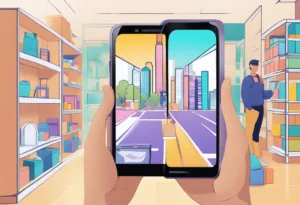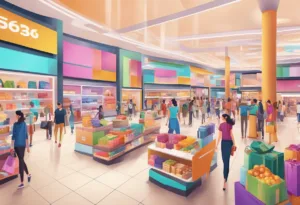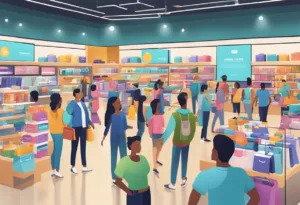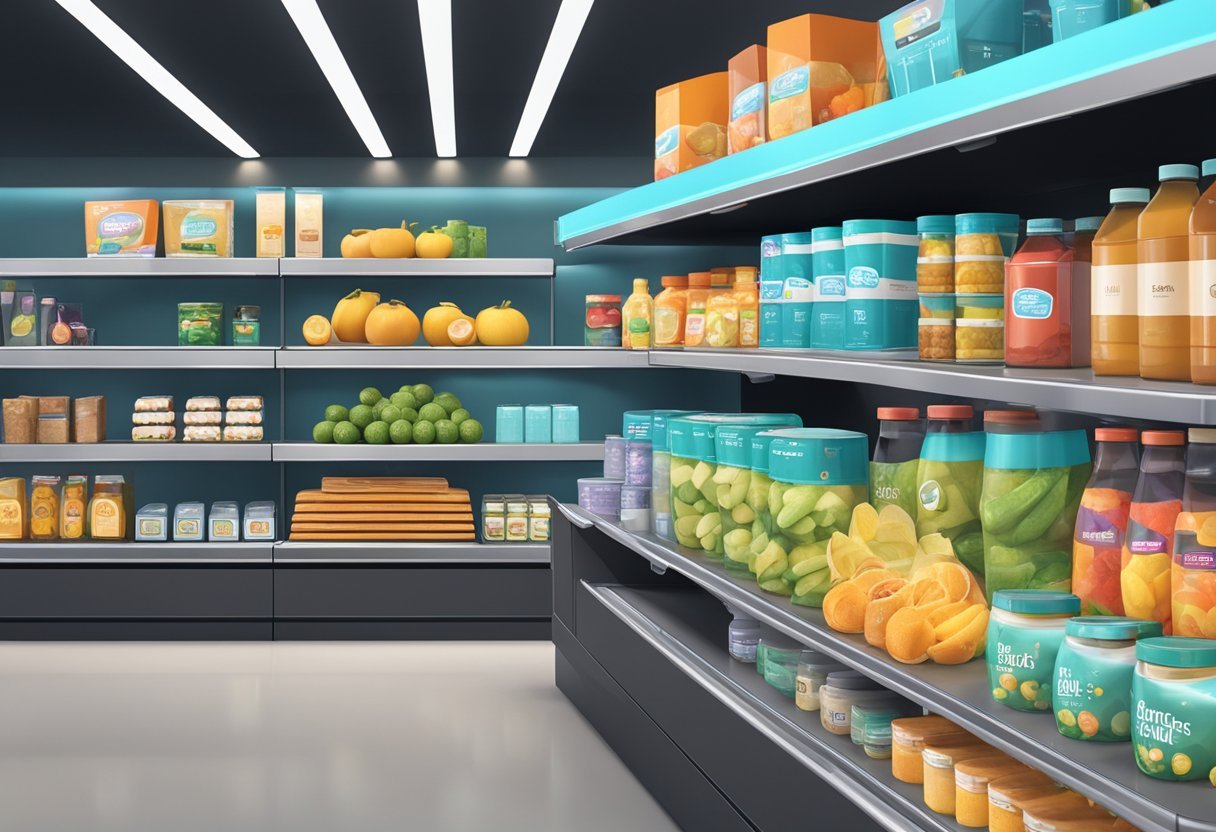Augmented Reality (AR) technology has revolutionized the way people shop. AR shopping allows consumers to experience products in an immersive and interactive way, making it a game-changer in the retail industry. AR technology superimposes virtual objects onto the real world, creating an enhanced shopping experience. In this blog post, I will share with you the concept of AR for shopping and how Augmented Reality is changing the shopping industry.
AR for shopping has evolved over the years, from being a futuristic concept to a reality. The technology’s foundation is built on computer vision, which enables the system to recognize real-world objects and superimpose virtual objects onto them. With the rise of smartphones and tablets, AR shopping has become more accessible to consumers, making it a popular trend in the retail industry.
AR shopping experiences vary across different industries, from trying on clothes virtually to visualizing furniture in a real-world setting. AR technology has also impacted the business world, enabling retailers to increase customer engagement and drive sales. As consumer behavior continues to evolve, AR technology is expected to play a significant role in shaping the future of retail.
Evolution of AR in Shopping
From Virtual Reality to AR
Augmented reality (AR) is a technology that overlays digital information onto the real world. AR has been around for a while, but it has only recently become more mainstream. AR has evolved from virtual reality (VR), which is a completely immersive experience. VR requires a headset and often a controller to navigate the virtual world. AR, on the other hand, can be experienced through a smartphone or tablet. AR uses the camera on the device to overlay digital information onto the real world. This makes AR more accessible and easier to use than VR.
AR has been used in shopping to enhance the customer experience. AR allows customers to try on clothes virtually or see how furniture would look in their home. AR has also been used to provide more information about products. For example, a customer could use AR to scan a product and see reviews or additional information about the item.
Impact of COVID-19 on AR Adoption
The COVID-19 pandemic has accelerated the adoption of AR in shopping. With many stores closed or limiting capacity, customers have turned to online shopping. AR has been used to bridge the gap between online and in-person shopping experiences.
AR has allowed customers to see products in their own space without leaving their home. This has been especially useful for furniture shopping. Customers can see how a piece of furniture would look in their home without having to go to a store. AR has also been used to provide a more interactive shopping experience. For example, a customer could use AR to see how a makeup product would look on their face or how a pair of shoes would look on their feet.
15 Ways Augmented Reality Is Changing Shopping

- Virtual Try-On Solutions
- AR-Enabled Smart Mirrors
- Interactive Store Windows
- In-Store Navigation Assistance
- Enhanced Product Information
- Virtual Interior Design
- Instant Access to Reviews and Ratings
- Immersive 3D Product Previews
- Personalized Shopping Experiences
- AR-Powered Advertising and Marketing
- Gamification of Shopping
- AR for Accessibility
- Social Shopping with AR
- Contactless Shopping Solutions
- AR-Driven Customer Insights
Virtual Try-On Solutions
Augmented reality for shopping is revolutionizing the fitting room experience with virtual try-on solutions. Shoppers can now try on clothes, accessories, and even makeup virtually using their smartphones or in-store kiosks. This technology enables customers to quickly see how different products look on them without the need to physically change outfits, reducing the time spent in stores and increasing convenience. Virtual try-ons are becoming a key differentiator in retail, offering a personalized and engaging shopping experience that drives purchase confidence and satisfaction.
AR-Enabled Smart Mirrors
AR-enabled smart mirrors are changing the shopping experience by allowing customers to see how they would look in different clothing items without physically trying them on. These mirrors can superimpose various outfits onto the customer’s reflection, providing instant visual feedback.
This not only speeds up the decision-making process but also adds an element of fun and interaction to the shopping journey. Smart mirrors represent a significant step forward in blending digital convenience with the brick-and-mortar experience.
Interactive Store Windows
Interactive store windows are utilizing AR for shopping to captivate passersby and draw them into stores. Retailers are using AR displays that respond to customer movements or allow them to interact with the content by using their smartphones. This innovative approach to window shopping can showcase products in dynamic ways, tell brand stories, and even enable direct purchases from the sidewalk, extending the shopping experience beyond the physical store space.
In-Store Navigation Assistance
In-store navigation assistance with AR is simplifying the shopping experience by helping customers find their way around complex store layouts. AR apps can provide directions to specific products, highlight promotions, and offer the most efficient routes through the store, saving customers time and enhancing their shopping experience. This use of AR for shopping is particularly beneficial in large department stores or malls where finding items can be challenging.
Enhanced Product Information
Augmented reality is providing shoppers with enhanced product information at their fingertips. By scanning items with their smartphones, customers can access detailed product specifications, see how the product works, or watch related content. This level of information empowers consumers to make more informed decisions and can lead to higher satisfaction with their purchases.
Virtual Interior Design
AR for shopping is transforming how customers buy home decor and furniture. With AR apps, users can visualize how products will look in their actual living spaces, checking size, color, and style compatibility. This immersive approach reduces the guesswork involved in interior design, leading to more confident purchases and fewer returns.
Instant Access to Reviews and Ratings
AR technology is giving shoppers instant access to reviews and ratings while they browse in-store. By simply scanning a product with an AR-enabled device, customers can see what others have said about the item, making it easier to decide whether to buy. This integration of digital data into the physical shopping experience is enhancing customer trust and streamlining the purchase process.
Immersive 3D Product Previews
Immersive 3D product previews via AR are changing the way customers interact with products before buying. Shoppers can now see lifelike 3D models of products from all angles, giving them a better understanding of what they’re purchasing. This is particularly useful for online shopping, where customers can’t physically examine products, and for in-store displays where products are kept in boxes.
Personalized Shopping Experiences
AR for shopping is enabling highly personalized shopping experiences. Retailers can offer AR features that suggest products based on customer preferences, past purchases, or even current outfits. This tailored approach makes shopping more efficient and enjoyable, as customers are presented with options that resonate with their personal style and needs.
AR-Powered Advertising and Marketing
Augmented reality is revolutionizing retail advertising and marketing by creating immersive campaigns that engage customers in unique ways. Through AR, brands can develop interactive ads that allow customers to explore products virtually, participate in virtual events, or unlock special offers. This interactive content can increase customer engagement and drive sales more effectively than traditional advertising methods.
Gamification of Shopping
The gamification of shopping through AR is making the retail experience more engaging and entertaining. Retailers are developing AR games that reward customers for visiting stores, finding products, or learning about new items. This playful approach to shopping can increase customer loyalty, encourage repeat visits, and make shopping a more memorable experience.
AR for Accessibility
AR for shopping is improving accessibility for customers with disabilities. AR technology can assist visually impaired shoppers by providing audio descriptions of products or navigating through stores. It can also offer sign language interpretation for the hearing impaired. This inclusive approach not only enhances the shopping experience for all customers but also reflects positively on the brand’s commitment to accessibility.
Social Shopping with AR
Social shopping with AR is allowing friends and family to shop together virtually. Users can share their AR shopping experiences in real-time, get feedback from their social circles, or even see what products their friends are interacting with. This social aspect of shopping is being enhanced by AR, making it a shared experience even when individuals can’t physically shop together.
Contactless Shopping Solutions
Contactless shopping solutions powered by AR are becoming increasingly important for health and safety reasons. AR can enable customers to interact with products, get information, and make purchases without touching surfaces or products. This contactless approach is particularly relevant in the context of health concerns and can streamline the shopping process.
AR-Driven Customer Insights
AR-driven customer insights are providing retailers with valuable data on shopper behaviors and preferences. By analyzing how customers interact with AR features, retailers can gain insights into which products are most attractive, how to improve store layouts, and what promotions are most effective. This data-driven approach can lead to more effective inventory management, marketing strategies, and overall customer satisfaction.
Technological Foundations of AR Shopping

AR shopping is a rapidly growing field, and it relies on several technological foundations to create the immersive experiences that customers expect. Two of the most important technological foundations of AR shopping are AR technologies and platforms, and 3D modeling and computer vision.
AR Technologies and Platforms
AR technologies and platforms are essential for creating AR shopping experiences. They allow developers to create and deploy AR applications that can be used on a variety of devices, including smartphones, tablets, and AR glasses. Some of the most popular AR technologies and platforms include Google ARCore, Apple ARKit, and Meta’s AR platform.
Google ARCore is a platform that allows developers to create AR applications for Android devices. It uses computer vision to track the position of the device in real-time, allowing AR objects to be placed accurately in the environment.
Apple ARKit is a similar platform for iOS devices, and it uses advanced computer vision algorithms to create highly accurate AR experiences. Meta’s AR platform is a more recent addition to the market, but it has already gained a lot of attention for its advanced capabilities.
3D Modeling and Computer Vision
3D modeling and computer vision are also critical components of AR shopping. 3D models are used to create the virtual objects that are overlaid onto the real world, and computer vision is used to track the position of the device and the user’s movements.
Computer vision is particularly important for AR shopping because it allows AR applications to create highly accurate and realistic virtual objects that are seamlessly integrated into the real world. This is achieved through the use of advanced algorithms that can detect and track objects in real-time.
The technological foundations of AR shopping are complex and require a high degree of expertise to develop and deploy. However, with the right tools and knowledge, developers can create highly immersive and engaging AR shopping experiences that are sure to delight customers.
AR Shopping Experiences by Industry

Fashion and Beauty AR
AR has been a game-changer for the fashion and beauty industry. With AR, customers can try on clothes and makeup virtually before purchasing them. L’Oréal and Sephora are two of the big names in the beauty industry that have incorporated AR into their shopping experience.
L’Oréal offers an AR-powered makeup try-on feature that allows customers to see how different products would look on their faces. Sephora’s Virtual Artist feature lets customers try on makeup virtually, and even gives them recommendations based on their skin tone and preferences.
In the fashion industry, AR has been used to enhance the shopping experience by allowing customers to virtually try on clothes before purchasing them. One example is H&M’s AR app, which allows customers to try on clothes virtually using their smartphone cameras. This feature has made it easier for customers to shop online, as they can see how the clothes would look on them before making a purchase.
Furniture and Home Goods
AR has also been used in the furniture and home goods industry to enhance the shopping experience. IKEA’s AR app, for example, allows customers to see how furniture would look in their homes before making a purchase. This feature has made it easier for customers to visualize how furniture would fit in their homes, and has reduced the number of returns due to mismatched furniture.
Footwear and Accessories
AR has been used in the footwear and accessories industry to enhance the shopping experience by allowing customers to virtually try on shoes and accessories before purchasing them. Nike’s SNKRS app, for example, allows customers to see how different sneakers would look on their feet before making a purchase. This feature has made it easier for customers to shop online, as they can see how the shoes would look on them before making a purchase.
The Business Impact of AR

Augmented Reality (AR) technology has the potential to significantly impact the retail industry. By introducing AR to the shopping experience, retailers can improve conversion rates and sales, while also streamlining their supply chain and inventory management processes.
Conversion Rates and Sales
AR technology can be used to provide customers with a more immersive shopping experience. By allowing customers to visualize products in a real-world setting, AR can help customers make more informed purchasing decisions. This can lead to increased conversion rates and higher sales for retailers.
Shopify, for instance, has already introduced AR technology to its platform. This technology allows customers to see how a product would look in their home before making a purchase. Similarly, Wayfair has introduced AR technology to its app, allowing customers to visualize furniture in their homes before making a purchase.
Supply Chain and Inventory
AR technology can also help retailers streamline their supply chain and inventory management processes. By using AR to visualize and track inventory, retailers can reduce the risk of overstocking or understocking products. This can lead to more efficient supply chain management and reduced costs.
Target, for example, has introduced AR technology to its supply chain management processes. By using AR to track inventory in real-time, Target has been able to reduce the time it takes to restock products and improve its inventory accuracy.
Brands can also benefit from AR technology by allowing customers to visualize products in a real-world setting. This can help brands differentiate themselves from competitors and build stronger relationships with customers.
AR technology has the potential to significantly impact the retail industry. By improving conversion rates and sales, and streamlining supply chain and inventory management processes, retailers can benefit from increased efficiency and reduced costs. As AR technology continues to evolve, it is likely that more retailers and brands will adopt this technology to enhance the shopping experience for their customers.
Consumer Behavior and AR
Enhancing Customer Confidence
One of the major benefits of AR for shopping is its ability to enhance customer confidence. AR allows customers to interact with products in a virtual environment, providing them with a more realistic idea of how the product would look and feel in real life. This can help customers make more informed purchasing decisions, as they have a better understanding of the product they are buying.
Moreover, AR can also help customers overcome the challenges of online shopping, such as not being able to try on clothes or see how furniture would look in their home. By providing customers with an immersive and interactive experience, AR can help bridge the gap between online and offline shopping.
Meeting the Expectations of Gen Z
AR is particularly important for meeting the expectations of Gen Z consumers. This generation has grown up with technology and expects a high level of digital interactivity. AR can provide this interactivity, allowing Gen Z consumers to engage with products in a way that is both fun and informative.
In addition, Gen Z consumers are highly influenced by social media and are more likely to make purchasing decisions based on what they see online. AR can help brands create engaging and shareable content that resonates with this audience, leading to increased conversion lift and ultimately, sales.
Frequently Asked Questions
How can augmented reality technology improve the in-store shopping experience?
Augmented reality technology can enhance the in-store shopping experience by providing customers with a more interactive and personalized experience. With AR, customers can see how a product would look in their home, try on virtual clothing, and even receive real-time product information. This technology can help customers make more informed purchasing decisions and improve their overall shopping experience.
What are some successful implementations of AR in retail environments?
There have been many successful implementations of AR in retail environments. For example, IKEA’s AR app allows customers to see how furniture would look in their home before making a purchase. Sephora’s AR app allows customers to try on virtual makeup, and Lego’s AR app allows customers to see how a completed Lego set would look in real life. These implementations have increased customer engagement and improved the overall shopping experience.
In what ways does AR differ from VR when applied to the shopping industry?
AR and VR differ in how they are applied to the shopping industry. AR enhances the real world by overlaying digital information onto it, while VR immerses the user in a completely virtual environment. AR is more practical for the shopping industry because it allows customers to see how a product would look in their real-life environment. VR, on the other hand, is better suited for creating a completely immersive shopping experience.
How can AR apps assist customers in making better purchasing decisions?
AR apps can assist customers in making better purchasing decisions by allowing them to see how a product would look in their real-life environment. This can help customers determine if a product would fit in their home or if clothing would fit properly. AR apps can provide real-time product information, such as reviews and ratings, to help customers make more informed decisions.
What benefits do retailers gain by incorporating AR into their ecommerce platforms?
Retailers can gain many benefits by incorporating AR into their ecommerce platforms. AR can increase customer engagement and improve the overall shopping experience, leading to increased customer satisfaction and loyalty. AR can help reduce the number of product returns by allowing customers to see how a product would look in their real-life environment before making a purchase.
Can you describe a virtual reality shopping experience and its advantages over traditional online shopping?
A virtual reality shopping experience is a completely immersive experience that allows customers to browse and purchase products in a virtual environment. This experience can provide customers with a more engaging and interactive shopping experience, as they can see and interact with products in a more realistic way. Virtual reality shopping experiences can reduce the number of product returns by allowing customers to see how a product would look and feel before making a purchase.




